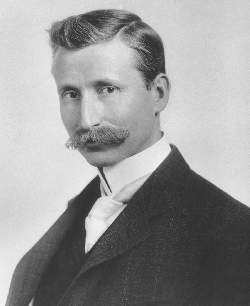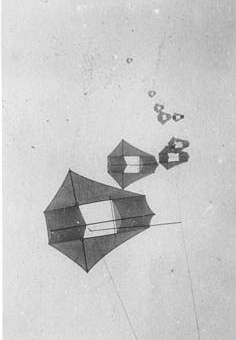
|
"The Hitherto Impossible in Photography Is Our Specialty"by Simon Baker |

|
"The Hitherto Impossible in Photography Is Our Specialty"by Simon Baker |
At 5:13 in the morning of Wednesday, April 18, 1906, the earth beneath San Francisco began to heave. Pressures that had been accumulating along the San Andreas fault were suddenly released, and it took a full minute for the colossal forces to spend themselves. In that time many places on the west side of the rift were thrust 16 or more feet to the northwest.
The fires began immediately, caused by overturned stoves, fallen chimneys, exploding gas mains, and downed wires. Firemen responded to dozens of calls, and everywhere they went they made the same awful discovery: there was little or no pressure in the water mains. The earthquake had destroyed San Francisco's water system.
For three and a half days the fires burned out of control. Finally the authorities resorted to dynamiting streets full of buildings and pumping water from the San Francisco Bay to stop the conflagration. Amid the smoldering ruins of 522 city blocks, more than 200,000 San Franciscans were left refugees in their own city.
News of the unparalleled disaster horrified the country. In Chicago, George R. Lawrence made plans to get to San Francisco as soon as possible and make a photographic record of the devastated city. Three weeks later he was there, hard at work with his crew. It must have been terribly difficult to work amid the chaos of a shattered city, but in the end his efforts provided a remarkable series of photographs, the likes of which had never been seen before.
One of his pictures in particular caught the attention of the world. "San Francisco in Ruins" showed the entire city on a single print 48¾ inches long and 17½ inches wide. The gargantuan image was not an enlargement; it was a contact print made from a single piece of film. Even today it is difficult to imagine a camera capable of making such a photograph. But it isn't just the size of the equipment that seems astonishing: when the famous photograph was made, the camera was hanging 2,000 feet above the San Francisco Bay.
 |
For the man whose business slogan was "The Hitherto Impossible in Photography Is Our Specialty," the making of this photograph was a routine matter. Lawrence had come a long way from his first encounter with commercial photography 16 years earlier, when he was a 23-year-old fresh off the family farm in Manteno, Illinois. In the 1890s he devised a method for synchronizing the firing of a series of flash charges and formulated a brighter flash powder. (His early flash experiments didn't always work out: one partially destroyed his hearing and blew his young son Raymond out the window). Five years later he won the Grand Prize of the World for Excellence in Photography at the Paris Exposition. The award honored Lawrence's design and construction of the world's largest camera: a 1,400-pound giant holding glass plates measuring eight by four and a half feet.
 Raymond, Lawrence's eldest son, helped out in early experiments with kite-borne cameras in Zion, Illinois. |
Soon even the tower wasn't high enough. For an assignment to photograph the Chicago stockyards in 1901, Lawrence modified a hydrogen balloon by removing the basket and replacing it with a wooden platform for himself and his equipment. On the fateful day of June 21, his work finished, he signaled for his crew to haul him down from his 900-foot perch. At about 200 feet the gas bag suddenly broke through its rope net and Lawrence and his camera plunged earthward. Fortunately, the force of the fall was broken by telephone and telegraph wires, and he landed unhurt. It took a second balloon mishap in Minnesota a month later to start Lawrence thinking about safer ways to send his camera into the air.

|
Lawrence's kite train (left) included
bamboo poles to keep the kites from
becoming entangled.
The Captive Airship was stabilized by three poles with weighted cords hung from the ends. |

| |
In 1902 Silas J. Conyne, a Chicago inventor, patented a kite for the purpose of carrying advertising banners above the city. Lawrence was impressed by the stability and lifting power of Conyne's kite and obtained the right from the inventor to build them. Sailing off on a kite was not what Lawrence had in mind, but using them to lift his camera seemed a possible alternative to dangerous balloons. If kite trains could lift a man into the sky, why not a large camera? He decided to follow the lead of Eddy and Woglom, but neither of them had ever sent up a camera of the size he had in mind. For the next few years Lawrence took time from his ground-based photography business to experiment with camera-lifting kite designs.
One after another he resolved the technical problems until all parts fell into place. He constructed a system that enabled up to 17 kites to be attached to the main kite line, though in practice he seldom used more than 10. To keep the kites from becoming entangled in the main line, he used six-foot bamboo poles as spacers between each kite and the main line. Controlling the pull of the kite train was accomplished by two men operating a winch. The camera itself was positioned below the last kite in the train. In order to operate the camera from the ground, Lawrence added a solenoid that would release the lens when activated by a battery-powered device, which was connected to the camera by an insulated wire running through the main line.
The most challenging question, of course, was how a camera dangling in the wind could be pointed at a subject and kept still enough to make a clear exposure. The solution was beautiful in its simplicity. The camera was mounted in a cradle, which in turn was attached to the main kite line by a tripod-like set of arms with a clamp at the top. Finally, the cradle was locked into position with a rigid arm extending from the tripod apparatus to the kite line.
To keep the whole set-up from swinging like a pendulum, Lawrence attached to the base of the cradle three wooden poles 120 degrees apart and about 15 feet long. At the end of each pole was a lead weight of several ounces, and from each weight dangled a fine silk cord 120 feet long. The three cord ends were tied together and a three-pound lead weight attached at that point.
The sum of all these parts was what Lawrence called the Captive Airship. At the heart of the system were the cameras, and Lawrence built his own, using wood and aluminum. The two types he designed for aerial work were modifications of commercial cameras of the day. One was an ordinary flat-plate camera having a fixed-focus lens with the usual leather bellows replaced by a lighter and cheaper metal frame covered with black cloth. The other had two features that enabled Lawrence to make panoramic photographs: a film plane that was semi-circular instead of flat and thus could accommodate very large pieces of film, and a fixed-focus lens that swung out horizontally on pivots to cover up to 160 degrees.
Since the cameras were mounted with their bases level and the kites were kept at a certain elevation, the lenses always pointed at the horizon. In order to record as much of the ground surface and as little of the sky as possible, Lawrence fitted his camera lenses below the horizontal mid-lines of the film plates. He made these cameras in several different sizes for a variety of purposes. The one that appears to have been used for the 1906 San Francisco photographs weighed 49 pounds.
In 1905 the Lawrence apparatus came to the attention of President Theodore Roosevelt, who saw possibilities for its use in times of war. Arrangements were made for a demonstration, which was conducted before a group of Army and Navy officers at Indian Head, Maryland, on May 22. This was followed a few days later by an attempt to launch the Captive Airship from a tugboat on the Potomac River. U.S. Navy Lieutenant L.H. Chandler reported to the Chief of the Bureau of Ordnance that further tests needed to be conducted at sea with the North Atlantic Fleet. With permission from the Department of the Navy, Lawrence and his assistants came aboard a battleship off New England on August 25 and worked there for nearly a week. The examining Naval officers concluded that the system of kites and cameras showed promise in spite of some problems. However, Lawrence withdrew his offer to sell the apparatus to the government when he could not get his price. Perhaps the only positive result of the various demonstrations is that they produced two U.S. Navy reports describing the Captive Airship in detail. Unfortunately, it appears that Lawrence himself never published anything about his methods.
The next significant event in his career as an aerial photographer was the San Francisco earthquake and fire. The "San Francisco in Ruins" photograph, more than anything else, brought him wide recognition and acclaim; it also reportedly brought him $15,000 for the publishing rights. After leaving the smoldering city, Lawrence traveled through California, making aerial photographs of Pacific Grove, San Jose, and Santa Cruz. The results, of course, were all for sale; Lawrence was, first and foremost, a commercial photographer.
Engaged by a Chicago financial firm with interests in western U.S. irrigation developments, Lawrence traveled through the region in 1908 taking bird's-eye photographs of project areas. That same year he returned to San Francisco and duplicated his panorama from over the bay in order to document the city's recovery efforts.
The end of his career as a commercial photographer was marked by a major endeavor. W .D. Boyce, a Chicago publisher, hired Lawrence to take charge of photography on an expedition to British East Africa. The objective was to get pictures of wild animals for a book Boyce was planning. No one had ever taken aerial night shots of wild animals before, and Lawrence took along two hydrogen balloons, an immense stock of iron filings and acid to generate hydrogen, a Captive Airship, towers, and plenty of flash powder.
The expedition occupied him from August to November 1909. His photography business ended shortly afterward. According to interviews with relatives, while he was in Africa his wife discovered he had been having an affair with one of his secretaries, and upon returning to the States Lawrence fled to California, taking his sons with him. During his absence, his business passed into the hands of two assistants.
 Lawrence designed and built this enclosed-cabin flying boat after his photographic career ended abruptly. |
Lawrence died in Chicago in 1938. To appreciate the achievements of his early years, one really needs to see his photographs in the original form--the Library of Congress in Washington, D.C., and the Chicago Historical Society have the best collections. And knowing the methods he used to obtain such unusual results helps one to see that Lawrence was something of a technological genius, a photographer whose work was never matched by any of his contemporaries. George R. Lawrence, the first commercial aerial photographer in the United States, stands alone in his inventive brilliance.